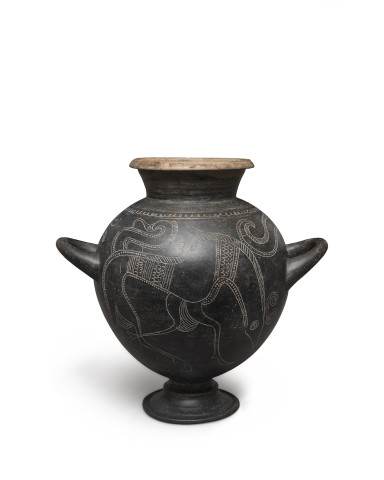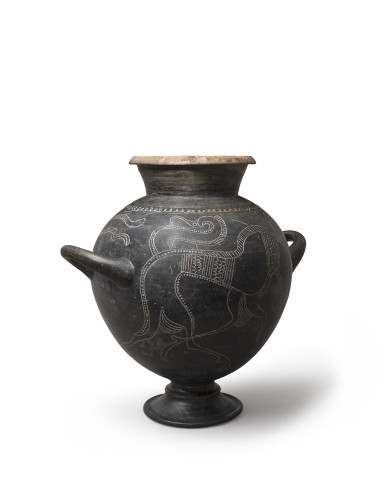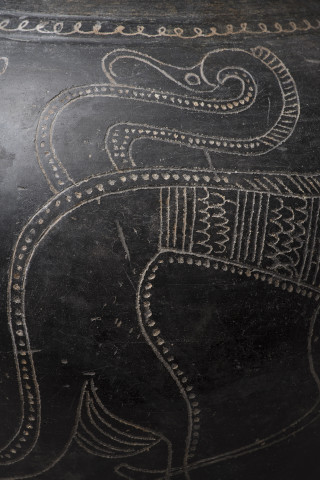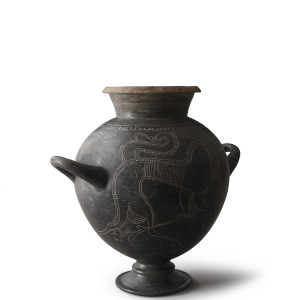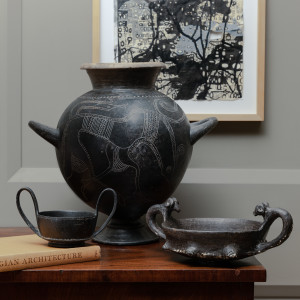Central Italian stamnos, Probably Faliscan, Capena, c.630-600 BC
Buccheroid impasto
Height: 34cm
10747
€ 40,000
Further images
The spherical body is decorated on both sides with an abstract depiction of a horse, the undulating bodies and limbs are fluidly incised onto the burnished brown-black surface, their elegant...
The spherical body is decorated on both sides with an abstract depiction of a horse, the undulating bodies and limbs are fluidly incised onto the burnished brown-black surface, their elegant legs tapering to vestigial hooves. Their downward curving heads with circular eyes are replicated at the tips of their tails, giving the latter an anthropomorphic nature. In the field between the pair are two further mythical creatures, reminiscent of a seahorse or eel; they could be creatures of the sky, or simply animal-shaped clouds.
The stamnos has a short upright neck and tilted, flat-topped rim. The two short, thick, round-sectioned handles are tilted upwards and widen at the junction with the belly. It has a spreading conical foot with two raised horizontal ribs. Recomposed from multiple fragments, with some insignificant lacunae made good, approximately half the foot restored, two Thermoluminescence test holes filled in.
This piece is typical of the end of the Orientalising period at Capena. The style is characterised by its richness and its taste for fabulous creatures. The incised lines and the burnished body mimic to some extent the similar graphic decoration drawn onto metal vases of the same period. The craftsmen working in this style paid emphasis to the decoration and strived for complexity.
Stamnoi of this type formed the principal element of the tableware at a banquet.
The stamnos has a short upright neck and tilted, flat-topped rim. The two short, thick, round-sectioned handles are tilted upwards and widen at the junction with the belly. It has a spreading conical foot with two raised horizontal ribs. Recomposed from multiple fragments, with some insignificant lacunae made good, approximately half the foot restored, two Thermoluminescence test holes filled in.
This piece is typical of the end of the Orientalising period at Capena. The style is characterised by its richness and its taste for fabulous creatures. The incised lines and the burnished body mimic to some extent the similar graphic decoration drawn onto metal vases of the same period. The craftsmen working in this style paid emphasis to the decoration and strived for complexity.
Stamnoi of this type formed the principal element of the tableware at a banquet.
Provenance
Elie Borowski, Basel, SwitzerlandPrivate collection, Belgium; acquired from the above, 1969
Private collection, Leuven, Belgium; by descent from the above, her uncle
Literature
Compare Bruce Gollan (trans.), The Art of the Italic Peoples from 3000 to 300 BC (Italy, 1993), p.202, No.102John W. Hayes, Etruscan and Italic Pottery in the Royal Ontario Museum: A Catalogue (Toronto, 1985), pp.44-45,
No. B22, and pp.49-50, No.B32
AlsoJette Christiansen & Nora M. Petersen, Catalogue Etruria II, Sculpture, Bronzes, Ceramics, Bucchero, Figure Decorated Ceramics, Complete Tomb Finds I. Tarquinia, II. Bologna, III.Cerveteri, Ny Carlsberg Glyptotek (Copenhagen, 2017), pp.210-211, No.79
